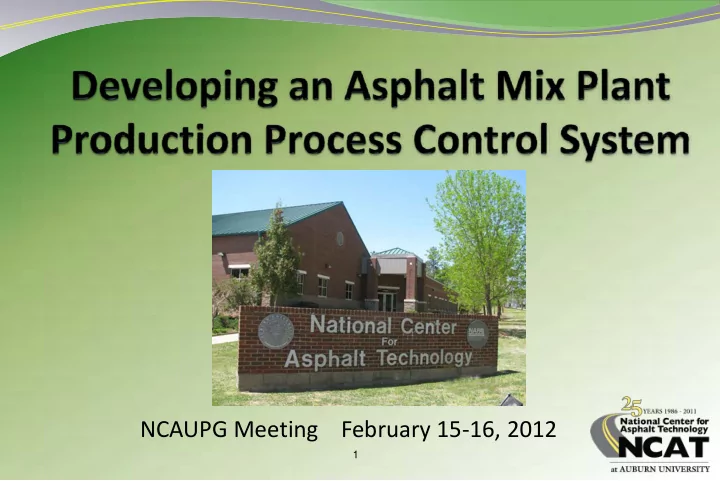

NCAUPG Meeting February 15-16, 2012 1
Recognition � FHWA � Dr Alice Smith, Dr Jeff Smith, Azgur Kabadurmus, Min Zhang Min, AU Industrial & System Engineering � Robert Troxler, Troxler Electronic Laboratories � Greg Brouse, QC manager, Eastern Industries, Inc., Winfield, PA 2 2
Aggregate cold feed Mineral Filler feed Baghouse Dust feed A 2 A 1 A n A 3 RAP feed(s) F D R 1 R 2 B 1 B 1 B 1 Binder tank(s) S 1 S 1 S 1 M Heating / Mixing Drum Mix silo / Surge bin
HOT MIX ASPHALT QUALITY ASSURANCE PROGRAM INDEPENDENT ASSURANCE AGGREGATE CONTRACTOR OWNER / AGENCY RAP QUALITY CONTROL ACCEPTANCE FILLER BINDER SAMPLING & MATERIAL PRODUCTION SAMPLING & TESTING AND DELIVERY TESTING SPECIFICATION SAMPLING & SAMPLING & CRITERIA MATERIAL HANDLING TESTING TESTING SAMPLING & PAY SAMPLING & MIXTURE PRODUCTION TESTING TESTING FACTOR SAMPLING & SAMPLING & MIXTURE STORAGE TESTING TESTING PROPORTION SAMPLING & SAMPLING & MIXTURE DELIVERY TESTING PRODUCTION TESTING RATE SAMPLING & SAMPLING & MIXTURE PLACEMENT TESTING TEMPERATURE TESTING SAMPLING & MOISTURE SAMPLING & MIXTURE COMPACTION TESTING TESTING
Real Time Voids 1 RTV / 35 tons Gmm ' Gmb ( adj ) − RTV 100 = × Gmm ' 5
6
7
Development of a Hot Mix Plant Production Process Control System V aggr = V geology +V aggrprod +V transport +V stockpile +V loader +V coldfeed +V s/t + e 8
Aggregate Blending Model • Decision Variable : Bin proportions for overall blend compliance • Objective Function : Minimize total deviation (normalized) from target gradations over 4 control sieves • Measured Parameter : Bin gradation measurements • Contraints: – JMF target gradation – Upper and lower specification limits – Upper and lower production limits – Upper and lower feed limits for each bin – Minimum and maximum limits on % Crushed, friction and natural sand – Aggregate properties for each bin: % Crushed, friction and natural sand 9 2/21/2012 9
Constraints OUT OF SPEC Re-optimize OKAY Compare NO CHANGE Combine HMA PRODUCTION •t 12 •t 11 •t 10 •t 9 •t 8 •t 7 •t 6 •t 5 •t 4 •t 3 •t 2 •t 1 •t 0
J.R.J. Lee, M.L. Smith, L.N. Smith 11
12
13
14
15
16
Sebastien Merit 2001 17
Simulation Model Why use simulation? – To compare the relative performance of different control policies – To mimic the system and adjust/fine tune the parameters of the optimization model – To estimate the benefits of the online control – To convince industry that the proposed model can improve the production quality 18 2/21/2012 18
19
Production Control Policies • No Control Policy: baseline to measure against • Control Policy 1 : Re-optimize the blend if gradation of one sieve is out of control • Control Policy 2 : Re-optimize the blend if gradations of two sieves are out of control • Control Policy 3 : Re-optimize the blend if total deviation from target is out of control • Control Policy 4 : Combine policy 1 & 3 20 2/21/2012 20
Typical Simulation Output 2/21/2012 21
Summary of the Results Scenario Trend 1 Trend 2 Trend 3 Control Policy Control 1 One Screen 20% 18% 36% Control 2 Two Screens 0% 19% 29% Control 3 Total Deviation 30% 20% 29% Control 4 (1 and 3) 20% 18% 39% Percent reduction of total deviation Using contractor production limits 4-Pt moving average 2/21/2012 22
Conclusions • Aggregate gradation continuous process control is feasible • The Aggregate Blending optimization is effective and sufficiently fast • Using computer simulation, the process parameters can be optimized and different scenarios can be tested and robust settings can be obtained without negatively impacting production • Image processing of aggregate gradation and accurate aggregate feed rate control are key to the system’s successful implementation 23 2/21/2012 23
Continuing Work • Develop the gradation imaging system • Determine the impact of moisture in the imaging • Improve the Control optimization algorithm to reduce “overshoot” and improve mix consistency • Test the optimization model at an asphalt production plant 24 2/21/2012 24
National Forum Dallas, TX, 22-23 September 2008 Forum identified following HURDLES towards implementation of this program • Cost/benefits of the system. The cost of the process control system vs tangible benefits for both contractors and agencies. • Need for a fundamental change in the industry and agency cultures • Existence of real advances in production process control technology • Need for a change in sampling/testing to support a real-time (quasi-continuous) measurement system 25
Aggregate cold feed Mineral Filler feed Baghouse Dust feed A 2 A 1 A n A 3 RAP feed(s) F D R 1 R 2 B 1 B 1 B 1 Binder tank(s) S 1 S 1 S 1 M Heating / Mixing Drum Mix silo / Surge bin
27
Recommend
More recommend